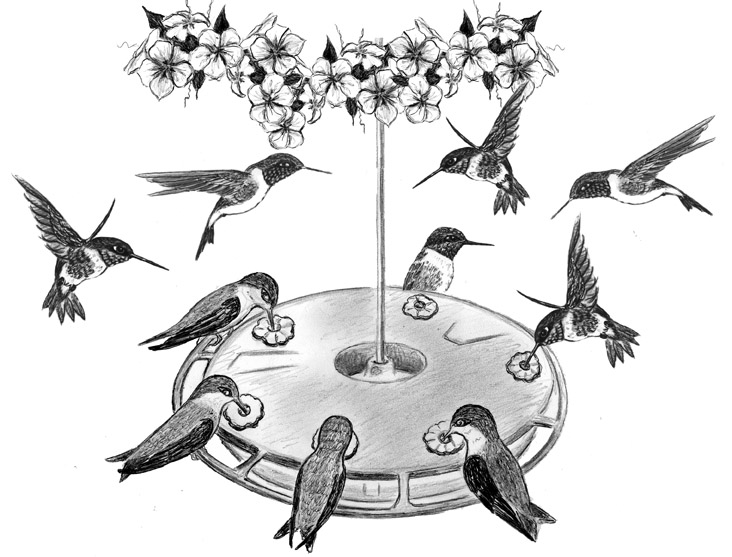
Dear Bird Folks,
In our yard we have two hummingbird feeders that have a total of eight feeding stations. We get lots of hummingbirds but never more than one at a time. I know they can be territorial, but I have seen pictures with clusters of hummingbirds on a single feeder. Why are our birds so antisocial?
– Sally, Brewster, MA
P.S. Love your column. Thanks for being a bright light.
OMG, Sally,
What a wonderful note. It totally made my day. Usually my opening paragraphs are a little silly or have some tongue-in-cheek comments about the question, or the questioner. Some readers think I do it to be a wise guy, but the truth is I’m just stalling until I can think of a real answer. It’s like when someone on the street asks you for directions to, say, Gull Lane, and you mumble a few words or engage in small talk until you can remember where the heck Gull Lane is. However, there are not going to be any wisecracks this time. I don’t want to take away from your kind words. No one has ever called me “a bright light” before. Oh, sure, I’ve heard “dim bulb” plenty of times, but never a bright light. Thank you for that.
You are totally right about hummingbirds being territorial. They not only defend their breeding territories, but they guard feeding areas as well. Finches and chickadees often squabble on sunflower feeders for the best position on the perch. Eventually, a bossy bird will force a meeker bird away. The dominant bird will then eat while the displaced bird merely moves to another perch and acts as if nothing ever happened.
This is not how things work in the world of hummingbirds. The aggressive hummer is not content when the intruder gives way; it wants the new bird out of town. This morning I was watching a hummingbird peacefully enjoying breakfast, when suddenly Mister Bossy buzzed in and drove the startled bird off the feeder, across the yard, above the treetops and eventually over the horizon. Experts aren’t totally sure why the birds behave this way, but I think if they ask any parent who has ever hosted a birthday party for a bunch of rowdy children, their explanation will always be: Way too much sugar.
It has been reported that hummingbirds will not only defend food sources on their breeding grounds, but also on their wintering grounds and even on their stops during migration. The word “sharing” is simply not in their vocabulary. If it’s true that they don’t like to share, you might be wondering why we regularly see photos of hummingbirds all clustered around a single feeder. Wait! You actually are wondering about that, which is why you wrote to me in first place. I knew that question sounded familiar.
Here in the eastern half of North America, 99% of the hummingbirds we see are Ruby-throated Hummingbirds. Yet things are quite different in the West. Out there the number of hummingbird species, as well as the overall number of birds, is much greater. Often there are just too many hummingbirds at a food source for any one bully to control. It’s like going on a picnic and trying to keep the flies out of the potato salad. If there are only one or two flies, we can manage to keep them away with the occasional wave of a napkin. But if dozens of flies arrive, we are forced to give up and let the flies have the potato salad, which really isn’t such a bad thing.
Years ago, on a birding trip to California I stopped at a yard where the owner had set up a number of hummer feeding stations. After introducing myself (I can’t believe the guy didn’t know who I was. What’s up with that?), I inquired about the feeder locations. The homeowner pointed to the side yard, to which I replied, “Near the cherry tree?” The guy just looked at me with a puzzled expression, as if I had just asked for directions to Gull Lane. I walked over to the feeders and then instantly understood why the guy was confused. The “cherry tree” turned about to be a dead shrub, which was totally covered in dazzling hummingbirds, all waiting for their turn on the crowded feeders. This is when I realized that I wasn’t on Cape Cod anymore.
Between now and the end of September, thousands of these tiny birds will be streaming down from northern New England and Canada. They’ll be hungry and will readily come to our feeders (and flowers). For any newbies reading this, it’s important to keep your feeders fresh and clean. Change the solution (which is one part sugar to four parts water) every three days regardless whether the birds have used them or not. Also, don’t be in a hurry to bring your feeders in the house after the bird traffic has slowed down. Just about every fall we get reports of late-feeding hummingbirds and often these birds are rare birds from the West. And don’t listen to your nosy neighbors who say your feeders will keep birds from migrating. Birds are programmed to get out of here before the snow comes in spite of the current food supply. However, a feeder might keep a lost hummer alive long enough to figure things out.
Here on Cape Cod, Sally, you’ll have to be content with seeing one or two hummingbirds at a time on your feeders. If you want to see “clusters” of them you’ll have to move to California, but I wouldn’t recommend it. Out there they don’t even know who I am. What’s up with that?